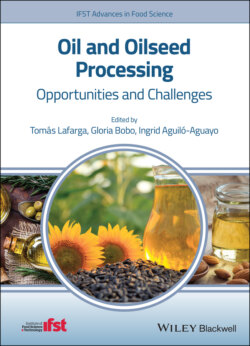Читать книгу Oil and Oilseed Processing - Ingrid Aguilo-Aguayo - Страница 26
1.3 Novel Sources for Oil Production
ОглавлениеSeveral unconventional raw materials are emerging as promising alternatives to conventional oilseeds for the production of edible oil for use in food, feed, and other industrial applications. These include, but are not limited to insects, microorganisms such as bacteria or microalgae, and seaweed. Insects with potential for being used as sources of edible oils were revised recently (Mariod et al. 2017). Most commonly consumed insects are beetles (Coleoptera, 31%), caterpillars (Lepidoptera, 18%), bees, wasps, and ants (14%), and grasshoppers, locusts, and crickets (Orthoptera, 13%) (FAO 2013). Their lipid content varies significantly among species and depends on what they have fed on, sex, environmental factors, or stage of development – overall, fat content varies between 7 and 77% on a dry weight basis (Dobermann et al. 2017). Insect‐derived lipids are generally liquid at room temperature and are therefore called “insect oils.” These are rich in unsaturated and essential fatty acids and have been suggested as potential ingredients for use in mayonnaises, vinaigrettes, as frying oils, and as food grade lubricants (Sosa and Fogliano 2017). Although insect consumption is not new for people living in some African and South East Asian countries, where at times up to 50% of dietary protein come from insects (Dobermann et al. 2017), it is still unfamiliar and has been associated with unappealing and negative sensory attributes in Western countries (Baker et al. 2016). In Thailand, for example, locusts (Patanga succincta) are such a popular snack that farmers grow crops specifically to feed them (Dobermann et al. 2017). Information on production and trade of edible insects is scarce. Zimbabwe exports caterpillars to Botswana, South Africa, Zambia, and the Democratic Republic of the Congo. Moreover, a case study conducted in the Central African Republic reported that the main importers of caterpillars were Chad, Nigeria, and Sudan, while the Central African Republic also exports caterpillars to African communities in Europe (FAO 2013). Thailand imports approximately 700 t of edible insects from Lao People's Democratic Republic and Cambodia (Yen et al. 2013).
Moreover, microalgae have been suggested as one of the most promising resources for generating oil for biodiesel production. Despite the huge efforts and significant amount of money invested over the last two decades the large‐scale technology needed to produce biodiesel from microalgae is still in its early stages of development (Islam et al. 2017; Lafarga 2020). Recently, Garrido‐Cardenas et al. (2018) reviewed the recent worldwide trends in the area of microalgae biotechnology and reported “lipids” as one of the most relevant keywords that appear in over 1000 scientific publications studied. Microalgae‐derived oil for human consumption shows potential for further development as, for example, docosahexaenoic acid‐ and eicosapentaenoic acid‐rich oil obtained from the microalgae Schizochytrium sp. has been accepted as a novel food in the EU according to Regulation (EU) 2015/2283 (EC 2015) and microalgae are one of the top trends in the food industry (Lafarga 2019). Currently, world production of microalgal biomass is estimated to be over 20 kt per year and increases an average of 10% per year (Acién‐Fernández et al. 2018). This value is likely to increase as studies have suggested a potential of producing 50 Mt of dried microalgal biomass in Europe alone (Skarka 2012). Macroalgae were also suggested as potential sources for oil production (Wang et al. 2013), although their lipid content is lower when compared to that of microalgae and are especially rich in carbohydrates (Lafarga et al. 2020). Overall, the production quantities and market value of these novel sources for oil production are very low. However, their huge potential suggests that microalgae‐ or insect‐derived oils will play an important role in the food industry of the future.
